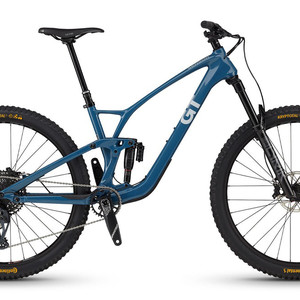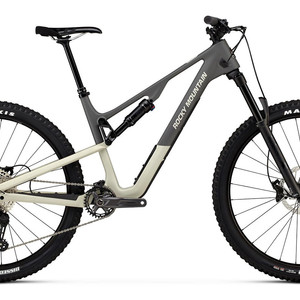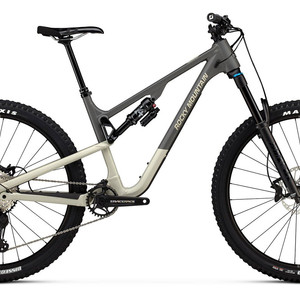2018 Transition Sentinel X01
(discontinued)
| Where To Buy | |||
|---|---|---|---|
Free shipping on orders over $50 (continental U.S. only).
International shipping available. Some exclusions apply. |
|||
Free shipping on orders over $50 (continental U.S. only).
International shipping available. Some exclusions apply. |
|||
During the 2018 Vital MTB Long-Travel 29er Test Sessions, the Transition Sentinel went head-to-head with four other leading bikes. What follows are our thoughts specific to the Sentinel. Be sure to check out the main feature for an in-depth comparison video, timed testing results, and more.
Highlights
- Aluminum frame
- 29-inch wheels
- 140mm (5.5-inches) of rear wheel travel // 160mm (6.3-inches) fork travel
- GiddyUp 2.0hh suspension
- Trunnion style 205x57.5mm Metric shock
- Shorter 44mm offset fork
- Molded rubber chainstay and downtube protection
- Rattle-free internal cable port covers
- External rear brake cable routing
- 180mm rear brake post mount
- Collet main pivot
- Enduro Max sealed bearings
- Threaded bottom bracket with ISCG05 mounts
- 1X-specific drivetrain
- Boost 148mm rear spacing with 12mm through axle
- Measured weight (size medium, no pedals): 32.4-pounds (14.7kg)
- Three year warranty
- MSRP $5,000 USD




Strengths
Transition has come up with an excellent combination of geometry and handling that makes low and slack viable in almost all trail conditions – just a few years ago long and slack almost certainly meant not that good at slow speed maneuvering. The Sentinel really excels when trails are fast, swoopy, jumpy, and anytime there is a change of direction. Leaning into turns feels incredibly natural.
It is happiest when pointed downhill, but can go uphill surprisingly well considering its girth. The bike is efficient and keeps its speed well – so well we were often speed-checking ourselves so as not to over-clear jumps. It is great at communicating what is going on with the tires thanks to slightly less rear travel and a stout rear end.

Handling feels fast and direct, but curiously never unstable. Our trust in the bike inspired us to go for some riskier but faster lines. It really must be experienced. We also appreciated extra room to move around the bike provided by the 170mm RockShox Reverb dropper post.
Weaknesses
The Sentinel's handling qualities gently bring you up to warp speed in no time, and the 140mm of not-so-progressive rear travel can get used up quickly when that happens in the rough. This can feel like the rear end is getting a little overwhelmed, making for a more jarring ride at times compared to many of the other bikes in our test.
The finish wasn't the most durable on our Sentinel, showing several paint chips after just a handful of good rides. At a frame weight of 9.3-pounds (4.2kg), it's a good deal heavier than most. There is no getting around the fact that you will not have the lightest bike out there on the aluminum Sentinel.


Suggested upgrades for a few hundred dollars: A meatier front tire and 200mm front rotor would go a long way on this ride. We'd also add some chain slap protection to the inside of the seatstay and some 3M vinyl all over to keep the paint fresh.
Geometry


Suspension Analysis
Using the bike industry's leading linkage analysis software, André Santos was able to determine a close approximation of the Sentinel's kinematics for the purpose of this review. Though they don't always tell the full story, these charts provide great insight into several key factors that impact how it rides.




André's Observations:
- The Sentinel is a slightly progressive bike at 11%, meaning that it’s relatively easy to use full travel. You may experience some harsh bottom-outs on heavier impacts.
- Great pedaling efficiency with 110% anti-squat values on most rear cogs for a 30-tooth chainring.
- The amount of chain growth and pedal kickback are less than normal for the segment.
- Quite low anti-rise values at near 40%. This means that the suspension is relatively unaffected by braking forces, but there is still some geometry preservation under rear braking.
- Overall, the Sentinel is a slightly progressive bike with very good pedaling efficiency.
Vital's preferred suspension settings for a 175-pound rider on stock components: 33% (19mm) sag // LSC - 4 clicks from full firm

What's The Bottom Line?
Transition's Sentinel is an exceptional ride. Despite being heavy, short on rear travel, and having the smallest tires in the test, it just oozes fun and confidence. The front and rear balance is good and trail feel is spectacular – until it gets super chunky, that is, when others in its class outshine it a little. The shorter rear travel aids with climbing efficiency and makes it better suited to a wider range of trails than full-on brawler long-travel 29ers. A skilled rider will get along with this bike really well, while riders gaining more experience will be able to progress quickly because of how communicative it is. Can the Transition get you into bad situations? Sure, but when you're at the limits, the Sentinel will let you walk that line extremely well. If you can afford more, we'd suggest investing in the carbon frame and saving 2.5-pounds.
Visit www.transitionbikes.com and the 2018 Vital MTB Long-Travel 29er Test Sessions feature for more details.
Vital MTB Rating


About The Testers
Steve Wentz - Age: 33 // Years Riding: 21 // Height: 5'8" (1.73m) // Weight: 174-pounds (78.9kg)
"Despite what it looks like, I'm really precise and calculated, which I'm trying to get away from. I'm trying to drop my heels more and just let it go." Steve is able to set up a bike close to perfectly within minutes, ride at close to 100% on new trails and replicate what he did that first time over and over. He's been racing Pro DH for 15+ years including World Cups, routinely tests out prototype products, and can squish a bike harder than anyone else we know. Today he builds some of the best trails in the world.
Brandon Turman - Age: 31 // Years Riding: 16 // Height: 5'10" (1.78m) // Weight: 175-pounds (79.4kg)
"I like to have fun, pop off the bonus lines on the sides of the trail, get aggressive when I feel in tune with a bike, and really mash on the pedals and open it up when pointed downhill." Formerly a Mechanical Engineer and Pro downhill racer, Brandon brings a unique perspective to the testing game as Vital MTB's resident product guy. He has on-trail familiarity with nearly every new innovation in our sport from the past several years and a really good feel for what's what.
Photos by Luca Cometti // Video by gordo with assistance from Suspended Productions
1 member reviews
NOTE: This is not a Vital Review, I am simply following the format, as I think it is well structured, and would like to use it to allow a common read of a review.
So a few weeks back Transition released a video detailing their new SBG geometry, (seen HERE) where they described how lengthening the top tubes, and increasing seat-tube angle can improve rider. But the thing that really peaked my interested was the last item integral to SBG, the reduction of fork offset from 56mm to a 44mm offset. As described in the video, this is suppose to improve stability and assist with cornering, as it forces the rider to weight the front wheel more.
With me being in the market for a new bike, and a newly released bike with all sort of new "standards" available for purchase, I had to go ride one to see what the hype was all about. So my buddy Stefan and I headed out to Transition HQ in Bellingham WA to demo the new Sentinel on a cold, snowy, November Saturday!
Transition Sentinel Highlights
- "Made for 29er haters" Although they are becoming harder to find these days
- 140mm of travel in the back 160mm travel up front
- Reduced offset fork: 44mm Fox, 42 Rock Shox
- Horst Link Suspension (FSR)
- Internal cable routing
- Water bottle mount
- Molded rubber protection
- Enduro max sealed bearings
- Trunion mounted shock
- Boost spacing 110mm front 148mm back
- Three build kits available: X01 ($4999), GX ($3999), and NX ($2999) - Frame only ($1999)
- Four Sizes S, M, L, XL
- Weight - Not sure but, how many people really care about this these days?

Geometry

The Sentinel's geometry looks very, very aggressive on paper, with a extra long amount of reach, a 64 degree head angle which is the same as my old Banshee Ledgend MKII, and an enormous wheelbase. However once riding, it feels much more reasonable - further details below.
I stand at about 5'6" tall, which puts me firmly between a small and medium sized frame with most manufacturers. Liking a tad more reach has me generally size up to accommodate that, where prior bikes I've owned have all been medium frames. Comparing the geometry charts to those other bikes to the Sentinel makes the effective top tube length on the Sentinel seem, very large. So much so, that I was prepared to only look at a size small. I reached out to Transition to confirm this theory, where I was actually told to stick with a medium size. Once sitting on the medium Sentinel, it became apparent that it was in fact the correct size, and felt comparable in reach to my Spartan. Moral of the story is, if you are a bit confused, ask for some help.
On The Trail
Stefan and I picked up the Sentinel's on the first weekend they were available for demo from Transition. The prior day, Bellingham had received about 4" of snowfall, and temperatures were hovering around mid to low 30's throughout the day.
We promptly set the bikes up to our suspension liking and headed over to the extensive network of trails just outside of Bellingham called Galbraith Mountain. Sitting in the parking lot on the bikes one of the first things we was how comfortable we both felt on the bikes immediately, even with a "long" reach in the cockpit on paper, these bikes actually felt normal, if not slightly shorter than we were used to. I would state that for seated pedaling, I was less stretched than I was on my following.
Our ride started out with some single track climbing which included some tight switchbacks. This gave an excellent opportunity to test out an area I thought the Sentinel would be terrible at, slow speed maneuverability, to my surprise the bike handled them rather well, furthermore as the ride progressed the Sentinel did not feel long during slow maneuvering around flat corners.
Now, even though it did handle those switchbacks well, I will be the first to say that this bike will not be winning any XC races. Pedal efficiency was good, but not nearly as snappy as others out there. However, over our three hour ride, I found myself quite happy with the suspension set in the "trail" or middle pedal setting on the shock, and it provided a great balance between support, and traction. Additionally, for a bike as supple as the it is, the Sentinel pedals far more efficiently than most.

Pointing the bike down the hill really brought the soul out of the Sentinel, this thing is a bruiser. The slack head angle, and long chainstays encourage me to get up to speed and keep that speed over terrain. Even with snow on ground, traction in corners was superb, and momentum over rough roots and rocks made them seem as if they were not there, with the ability to plow right over them. Stating the word "plow" is intentional, as at speed the Sentinel like to settle in and roll over the terrain rather than pop and float like some other bikes on the market.
Frankly it was mind blowing bringing this bike up to speed; the amount of stability provided while cruising at mach-3 was incredible and similar to that of the last downhill bike I've owned. I wish that we were able to have taken it on slightly more aggressive trails to better grasp the full potential and potential limit of the Sentinel.

On jumps, the Sentinel feels balanced, and while airborne I never felt bucked or nose heavy coming off of a lip.

In rhythm sections of berms, and jumps, the Sentinel carried great speed and traction, but would have benefited from slightly more suspension support in the mid-stroke, or slightly more low-speed compression damping, which is adjustable on the Fox DPX2 shock.
Issues
While the one ride I have had on this machine was brief, there were some issues that did arise which could be cause for concern.
The first was the water bottle cage position in the frame. In both the medium and large size frames we had issues fitting a full 26oz Purist bottle, without wedging into the cage.

Another issue I noticed was the amount of dirt and debris which built up rather quickly on the top surface of the chainstay. Not a huge area of concern, as the area is fairly open to remove debris, but the buildup was more than I have experienced on other bikes.

The last issue we both noticed, was on a fairly small ledge that was on the lower part of SST. It was a short 3' drop to flat, but created a harsh bottom out feeling in the rear end. The stock bike ships with two volume spacers in the shock, I would certainly add another to prevent this from happening in the future.
Build Kit
We both rode the Sentinel X01 build, and we were really impressed with the spec.
- The X01 drive-train worked flawlessly throughout the day
- Maxxis Minion DHF and DHRII provided ample traction, and would be a great choice of snow tire for your weekend ski trip.
- E.13 TRS+ wheels offered great engagement while offering excellent lateral support.
- 150mm travel Rock Shox Reverb!
- Fox 36 RC2 up front with Fox DPX2 rear shock
- ANVL Forge Stealth Saddle was... eh...ok, not my favorite but it got the job done.
- But really the standout star on build of the Sentinel was the code RSC brakes. Wow these things are amazing! Super consistent, tons of power, and great modulation!
All in all a really stellar build kit, which is hard to beat at a bike that retails for $5K.
The Bottom Line
So who is the Transition Sentinel for? This may be for some, the only part of this review they read.
In my mind, the Sentinel is for the trail/enduro rider who really likes to go fast down the hill where chunky terrain, and sustainable high speeds exist. Where the time taken to get to the top of the hill needs to be done efficiently but not at the highest priority. I've ridden in quite of few places and of those places, the Sentinel would be great in Santa Cruz, Southern Ca, and the PNW. Areas where the primary riding style is smoother easier climbs, but with fairly full-on descents.
Additionally, the bike is not going to be for the trail or enduro rider who likes to pop and jump off of every feature in the trail. The longer length of the bike, made it more difficult to manual, as well as pick up and put down as other trail 29ers.
Stefan and I wrapped up the day with a Party in the Woods IPA at Transition HQ with the thought of: "whoa this thing is a winner", and the Sentinel on the short list for a next bike.

Conroy's Rating
- Climbing: 3.5 stars - Very Good
- Descending: 4.5 stars - Outstanding
- Fun Factor: 4 stars - Excellent
- Value: 4 stars - Good
- Overall Impression: 4 stars - Excellent
About The Reviewer
Ryan Conroy - Age: 29 // Years Riding MTB: 11 // Height: 5'7" (1.70m) // Weight: 165-pounds (75kg)
I am a mechanical engineer who loves to bike and ski. Growing up primarily in the Northeast where I rode trail bikes and raced DH back in the day, I recently moved to the Seattle area from Austin, where I typically ride Tokul, Tiger, and 27. My current favorite trail is B-Line.
13 comments
Post a reply to: Sentinel - Short Test Ride
Specifications
Rattle-free internal cable port covers
External rear brake cable routing
180mm rear brake post mount
Collet main pivot
Enduro Max sealed bearings
| Where To Buy | |||
|---|---|---|---|
Free shipping on orders over $50 (continental U.S. only).
International shipping available. Some exclusions apply. |
|||
Free shipping on orders over $50 (continental U.S. only).
International shipping available. Some exclusions apply. |
|||























11 comments
Post a reply to: Review - 2018 Transition Sentinel X01 from Vital MTB Test Sessio